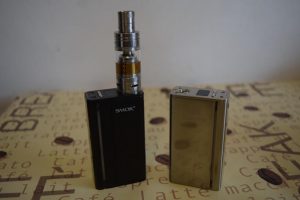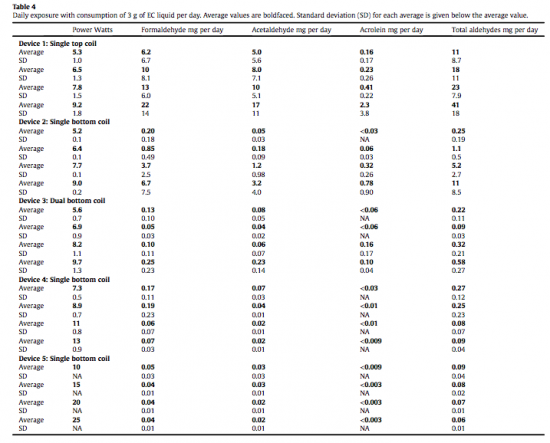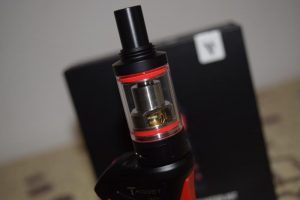Study Finds E-Cigarettes Release Considerably Less Aldehydes Than Analogs
There has been a lot of controversy surrounding the amount of formaldehyde emitted by electronic cigarettes, which is why a team of researchers set out to test a number of e-cigarettes and measure the levels of the known carcinogenic in the produced vapor. They found that even at the highest settings, e-cigarettes produce much less formaldehyde, acetaldehyde and acrolein than tobacco cigarettes.
 Last year, a scientific letter published in the New England Journal of Medicine warned of dangerously high levels of formaldehyde detected in e-cigarette vapor, sending shivers down the spines of millions of vapers across the world. Its authors concluded that at the highest setting the e-cigarettes they had used for their research produced five times more formaldehyde than regular cigarettes, making users up to 15 times more prone to cancer that smokers.
Last year, a scientific letter published in the New England Journal of Medicine warned of dangerously high levels of formaldehyde detected in e-cigarette vapor, sending shivers down the spines of millions of vapers across the world. Its authors concluded that at the highest setting the e-cigarettes they had used for their research produced five times more formaldehyde than regular cigarettes, making users up to 15 times more prone to cancer that smokers.
The subject was instantly picked up by the media and covered extensively, causing panic and outrage in the general public and controversy in scientific circles. A number of reputed scientist contested the findings, criticizing both the methodology used by Jensen et. al and their conclusions. Concerned about the devastating effects such information might have on the millions of smokers who might have otherwise attempted to quit smoking using electronic cigarettes, over 40 researchers wrote a letter to the New England Journal of Medicine in an effort to have the letter retracted. Their main argument was that the high level of formaldehyde was detected as a result of a ‘dry hit’ – when the vaporizer is cranked up to very high voltage and the coils burn through the wicking material. In real-life, no one would ever use e-cigarettes under these conditions because the taste and smell would be unbearable.
But in order to truly set things right, we needed another scientific study – done right this time. Enter Kurt Kistler, a chemistry professor at Pennsylvania State University, who teamed up with researchers at Enthalpy Analytical, a lab in North Carolina, to test five types of electronic cigarettes and measure the levels of adelhydes detected in the vapor.
Unlike the criticized research which had analyzed multiple devices but eventually lumped all of them under the results obtained from a single vaporizer, Kistler and his team made sure to disclose all the different setups they used and publish results separately for each one. Here are the five different tank-style cartridges used during testing: 1) a top-coil Vision CE4 clearomizer with three different resistance coils (2.2Ω, 2.8Ω and 3.4Ω), 2) a Kanger Protank 1 with a 2.7 Ω bottom single-coil-head, 3) an Innokin Gladius tank with a 2.8Ω bottom dual-coil-head, 4) an Aspire Nautilus tank with 2.2 Ω bottom single coil and 5) a Kanger SubTank with a 0.72 Ω bottom-coil-head. The first four devices we tested with an Innokin iTaste VV4 battery, while for the fifth an Evolv DNA40 power supply was used.

Each setup was attached to smoking machines and the smoking regime was a puff every 30 seconds with a 4-second duration.
Researchers then tested collected samples for for the presence of three different aldehydes – formaldehyde, acetaldehyde, and acrolein – known to be produced by heating mixtures of glycerol and propylene glycol. Formaldehyde, small levels of which are actually produced by the human body, is classified as a carcinogen, acetaldehyde is a potential carcinogen and acrolein is known to cause lung damage.
The study’s detailed results can be observed in the chart above. As you can see, they vary significantly depending on the setup and the power used during testing, something that Professor Kistler feels is critical to consider when doing research and formulating conclusions on electronic cigarettes. “There needs to be context because the term ‘electronic cigarette’ is not just one thing,” he said. “E-cigarettes include a huge variety of devices, power settings, wattage control, voltage control, and even temperature control.”
Three of the five tested samples produced far lower levels of aldehydes than smoking tobacco cigarettes. Even at their highest power settings, these devices formaldehyde, acetaldehyde, and acrolein levels of less than 1 milligram each per day compared to the 1.5-2.5 mg of formaldehyde, 10-30 mg of acetaldehyde, and 1.5-3 mg of acrolein a smoker is exposed to after smoking a pack of cigarettes. It’s also worth mentioning that the levels of aldehydes detected during testings were well below well below the exposure limits for these chemicals outlined by the Occupational Safety and Health Administration (OSHA).
One of the other two tested samples started producing higher levels of formaldehyde and acetaldehyde at its two highest settings, while the other produced extremely high quantities of these two chemicals throughout the testing process. In some cases these levels were 20 times higher than those observed during smoking.
Something was definitely off, and Kistler and his team have a very plausible theory – the coil could have become overheated, resulting in what is known as a dry puff. After completing the study, researchers noticed that the coil was charred, which further backs up their theory. While they can’t be sure that is what caused the high levels of aldehydes, evidence definitely points in that direction. Their published study also mentions that the tanks were all positioned horizontally during testing, which, depending on design, might have prevented the wicking material from saturating properly.
Kistler agrees that samples collected in dry puff conditions cannot be be considered relevant. “Dry puff is noxious,”  Kistler said. “It burns the nose. It burns the throat. It’s very, very unpleasant. No vaper is going to just sit there and inhale that. It kind of forces the vaper to just shut it off entirely.”
Kistler said. “It burns the nose. It burns the throat. It’s very, very unpleasant. No vaper is going to just sit there and inhale that. It kind of forces the vaper to just shut it off entirely.”
With literally hundreds of different tanks and vaporizer models available right now and new ones hitting the market virtually every day, the results from these five tested samples cannot hope to represent vaping in general. But it was exactly the concept of device variability that Kistler wanted to raise awareness about with this study. “We wanted to get a baseline and give people the information that these early studies were not the end of the story whatsoever.”
Although there is still a lot of work to be done, I think it’s fair to say that this study was a worthy response to the botched letter published by Jensen et. al. It shows that different types of e-cigs yield different results depending on a variety of factors and, most importantly, that the conclusion that e-cigarettes in general produce more aldehydes than tobacco cigarettes is not only dangerous but completely false.
















